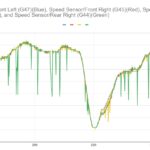The 0AW transmission, found in various Volkswagen and Audi vehicles, can sometimes exhibit jerky or rough shifting. This can often be remedied with a clutch adaptation using VCDS (Vag-Com Diagnostic System). This procedure helps the transmission control module (TCM) learn the optimal clutch engagement points, resulting in smoother gear changes. This guide outlines the necessary Vcds Procedures for performing a 0AW clutch adaptation.
Understanding 0AW Clutch Adaptation with VCDS
Before beginning the adaptation, it’s crucial to understand the process and prerequisites. The adaptation involves specific driving maneuvers and monitoring key measured values within VCDS. The transmission fluid temperature must be within a specific range for the adaptation to succeed.
Prerequisites for 0AW Clutch Adaptation
- Fault-Free TCM: Ensure no fault codes are present in the TCM before starting. Use VCDS to scan for any existing errors and address them accordingly.
- Optimal Fluid Temperature: The transmission fluid temperature needs to be between 80-95 degrees Celsius (176-203 degrees Fahrenheit). This is critical for successful adaptation. Achieving this temperature typically requires driving the vehicle in both D and R modes under varying loads, keeping the RPM below 1500.
- VCDS Access: You’ll need a genuine VCDS interface and software to access the necessary measured values and initiate the adaptation process.
Step-by-Step VCDS 0AW Clutch Adaptation Procedure
-
Connect VCDS: Connect your VCDS interface to the vehicle’s OBD-II port and launch the VCDS software.
-
Select Measured Values: Navigate to the TCM module within VCDS and select the following measured values:
- Adaptation of the forwards start-up behavior [LO] State
- Adaptation of the backwards start-up behavior [LO] State
- Transmission fluid temperature
- Specified clutch torque
-
Monitor Fluid Temperature: Monitor the transmission fluid temperature and ensure it reaches the required 80-95°C range.
-
Forward Adaptation (D):
-
With the vehicle stationary, select driving mode D.
-
Accelerate gently to approximately 6 mph (10 km/h).
-
Slowly brake to a complete stop using the foot brake.
-
Hold the brake pedal for 5-10 seconds after stopping.
-
Crucial: The specified clutch torque must remain above 20 Nm during braking. If it drops below, adjust your driving profile (lighter load, gentler braking) and repeat.
-
Repeat this process until the “Adaptation of the forwards start-up behavior [LO] State” indicates successful completion within VCDS.
-
-
Reverse Adaptation (R):
- With the vehicle stationary, select driving mode R.
- Repeat steps 4a-4e, ensuring the specified clutch torque remains above 20 Nm during braking.
- Repeat until the “Adaptation of the backwards start-up behavior [LO] State” indicates successful completion.
-
Post-Adaptation:
- After successful completion of both forward and reverse adaptations, leave the ignition on for at least six minutes. This allows the TCM to store the learned values. A terminal 15 reset (disconnecting the battery) will trigger the adaptation to run again on the next drive cycle.
Conclusion
Performing a 0AW clutch adaptation with VCDS can significantly improve the shifting quality of your vehicle. By following these VCDS procedures and paying close attention to the specified parameters, you can achieve smoother and more comfortable gear changes. Remember to diagnose and address any underlying fault codes before attempting this procedure.

